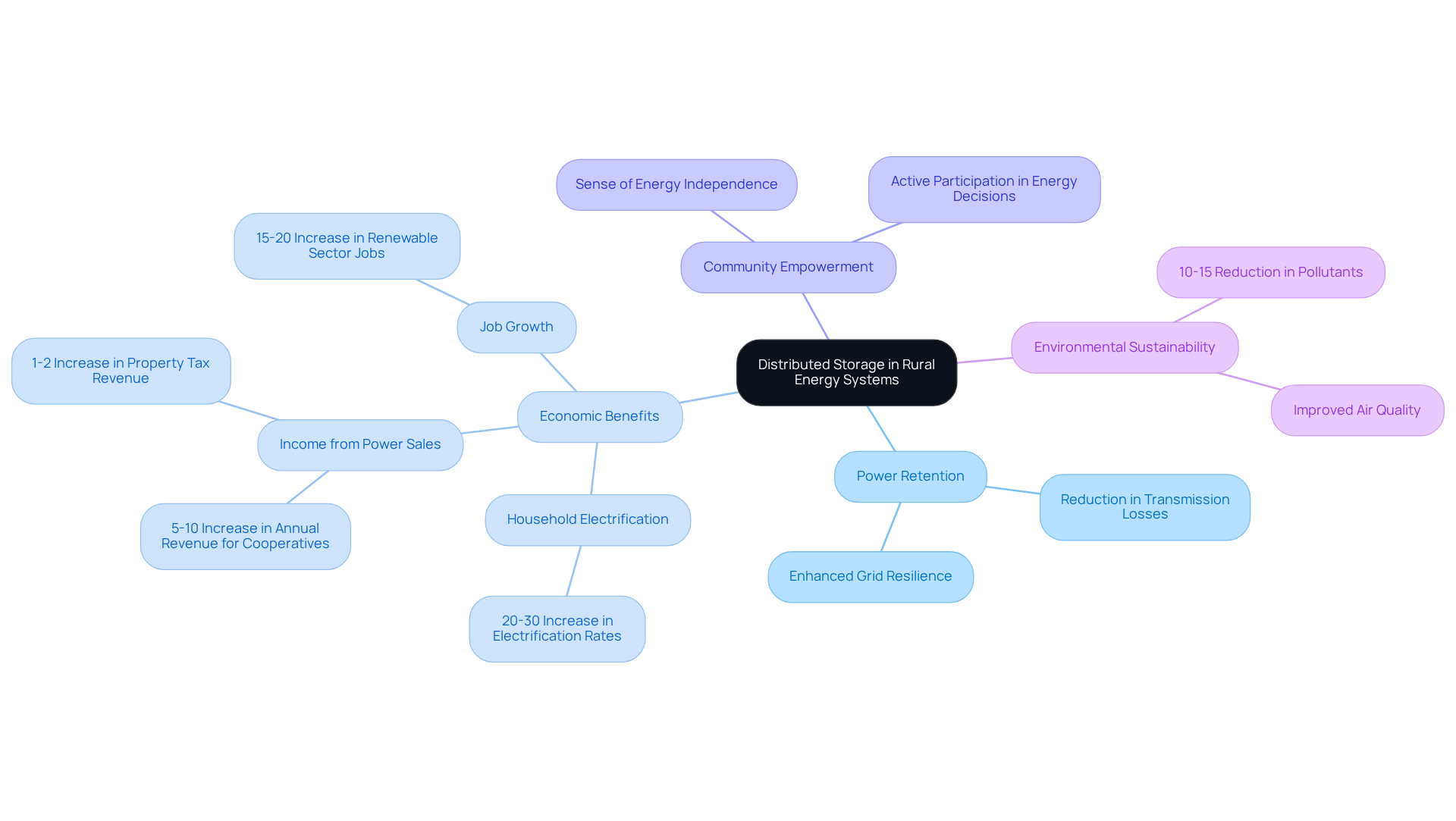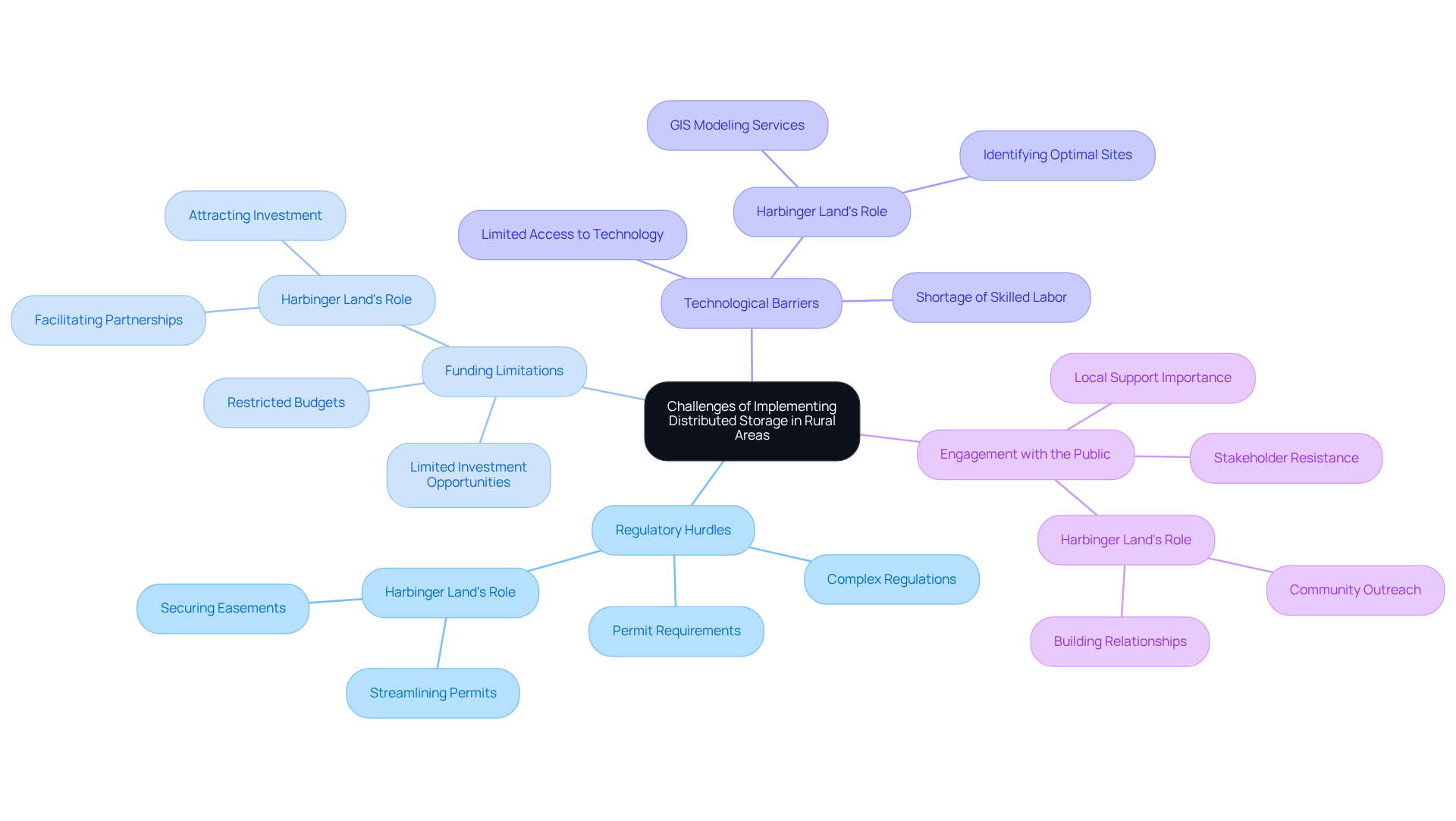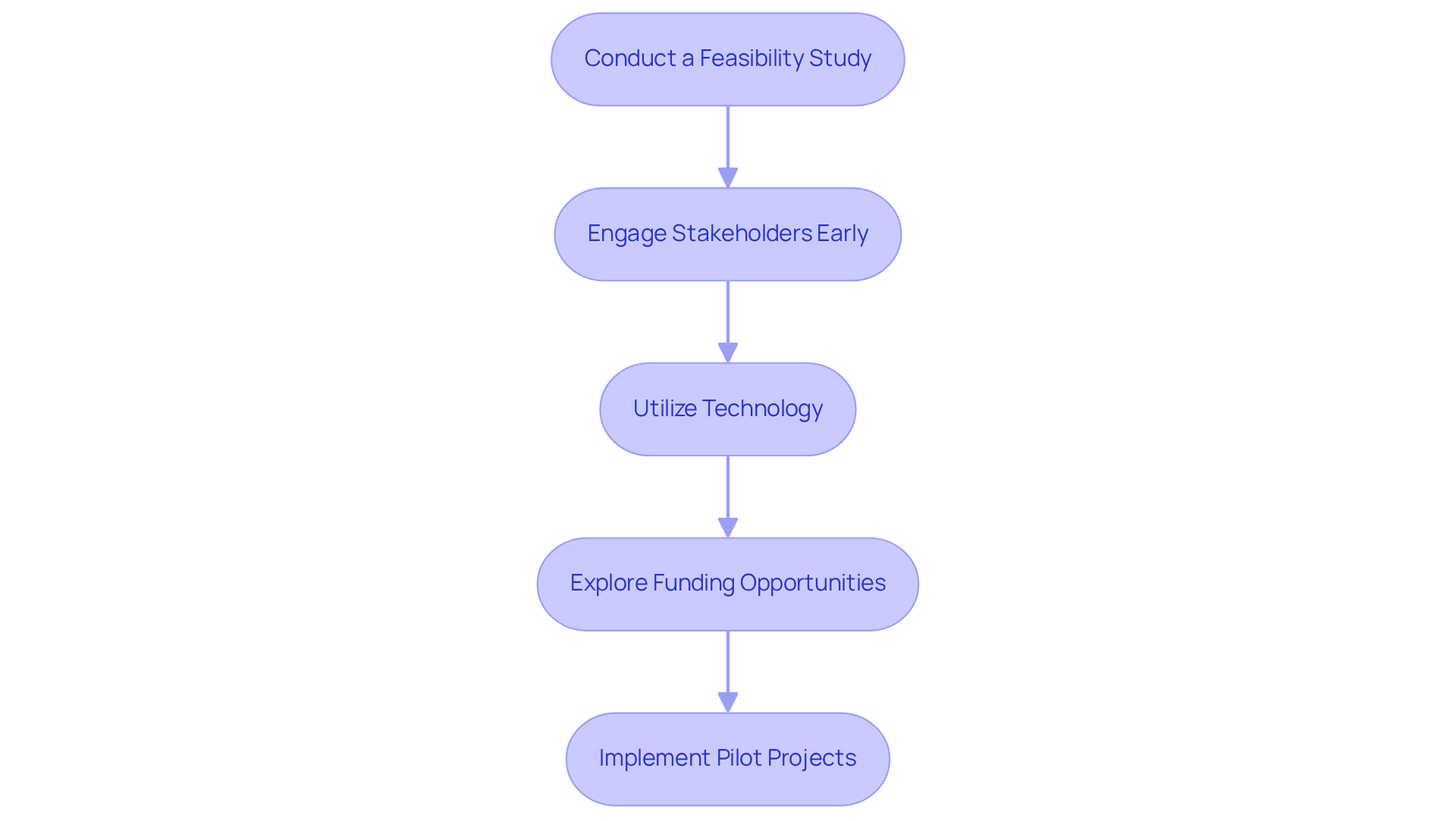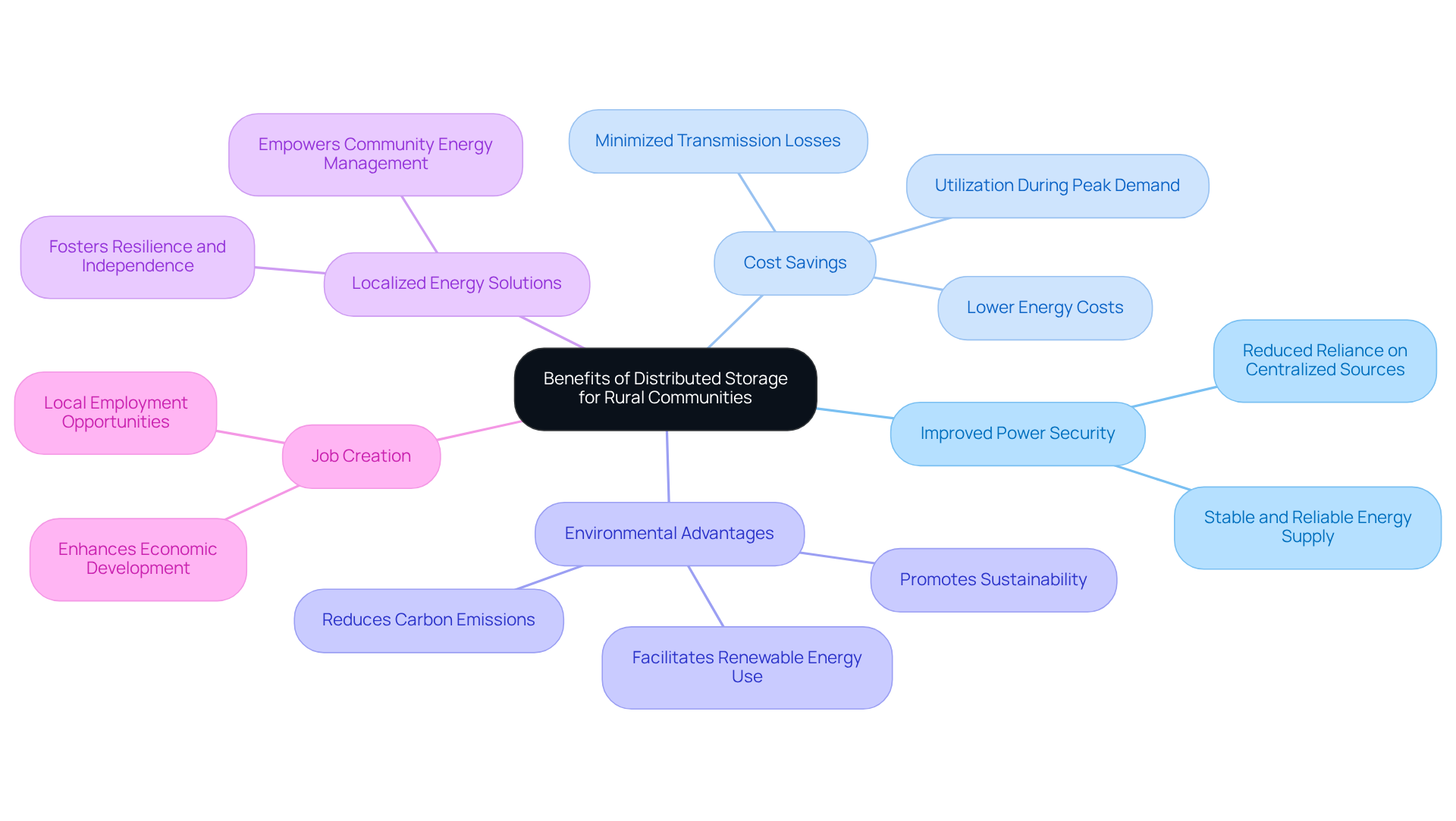Overview
This article presents key strategies for implementing distributed storage systems in rural areas, emphasizing their critical role in enhancing local energy security and driving economic development. It highlights that by engaging stakeholders and leveraging technology, communities can effectively navigate challenges such as regulatory hurdles and funding limitations. These strategies not only address immediate issues but also foster long-term community empowerment and sustainability.
Introduction
The transition to renewable energy sources is fundamentally transforming how rural communities access and manage their power.
Distributed storage systems present a remarkable opportunity, allowing these regions to leverage local resources while bolstering energy security and economic resilience.
However, the journey toward successful implementation is riddled with challenges, ranging from regulatory hurdles to funding limitations.
How can rural areas effectively navigate these obstacles to unlock the full potential of distributed storage?
Define Distributed Storage and Its Role in Rural Energy Systems
Distributed systems represent mechanisms that retain power locally, near the point of consumption, rather than relying on centralized facilities. This approach is crucial for remote power systems, enabling communities to efficiently harness renewable resources like solar and wind while storing surplus power for future use. By enhancing power security, localized reservoirs reduce transmission losses and bolster grid resilience, particularly benefiting remote regions that often encounter access and reliability challenges. Notably, research indicates a statistically significant negative coefficient for capacity related to unemployment rates, implying that increased capacity can positively influence local job markets.
Case studies illustrate the transformative impact of distributed storage for rural areas on communities. For instance, power retention initiatives have led to a 20-30% increase in household electrification rates in certain remote areas, significantly improving access to essential services. Additionally, rural electric cooperatives have reported a 5-10% rise in annual income from power sales and a 1-2% increase in property tax revenue due to hosting power retention facilities. This economic diversification is further supported by evidence of a 15-20% growth in jobs within renewable sectors, including technicians and project managers.
The role of decentralized data retention extends beyond mere resource management; it fosters a sense of community empowerment and autonomy. As rural areas transition to renewable energy and preservation solutions, the implementation of distributed storage for rural areas not only enhances their power security but also contributes to local economic development and environmental sustainability. This transition is underscored by a 10-15% reduction in particulate matter and nitrogen oxide levels in the atmosphere, highlighting the broader ecological benefits of localized power retention initiatives. As one observer noted, "Energy retention, by decentralizing power and enabling local renewable resources, could promote a sense of energy independence and collective empowerment." This encapsulates the significant transformations that distributed data management can bring to rural communities.

Identify Challenges of Implementing Distributed Storage in Rural Areas
Implementing distributed storage for rural areas presents significant challenges that must be addressed effectively. These challenges include:
-
Regulatory Hurdles: Navigating the complexities of local, state, and federal regulations can create substantial barriers. Projects often require extensive permits and adherence to numerous compliance standards, which can delay implementation and increase costs. Harbinger Land's expertise in site and right-of-way acquisitions streamlines this process, ensuring that all necessary easements are secured efficiently.
-
Funding limitations make it particularly difficult to secure funding for distributed storage for rural areas, as budgets are often restricted and investment opportunities may be limited. Harbinger Land assists in overcoming these funding limitations by facilitating partnerships and securing necessary easements that attract investment, thereby enhancing project viability.
-
Technological Barriers: Access to advanced technologies and skilled labor is frequently limited in rural areas. This shortage of resources can hinder the implementation of efficient storage solutions, thereby limiting the advantages of distributed storage for rural areas. By utilizing Harbinger Land's integrated GIS modeling services, optimal sites for technology deployment can be identified, mitigating some of these barriers.
-
Engagement with the Public: Gaining support from the local population is vital for project success. Stakeholders may have differing viewpoints on power initiatives; without effective engagement, projects may encounter resistance, impacting their acceptance and feasibility. Harbinger Land's comprehensive approach to site acquisitions includes community outreach, fostering better relationships and understanding among stakeholders.
Addressing these obstacles is crucial for the effective execution of distributed storage for rural areas, especially as the demand for efficient power management continues to rise in remote areas.

Outline Best Practices for Effective Distributed Storage Implementation
To effectively implement distributed storage for rural areas, it is essential to adopt best practices that ensure success and sustainability.
-
Conduct a Feasibility Study: Begin by assessing local energy demands, available resources, and potential holding locations. This foundational analysis guarantees alignment with public requirements and project viability.
-
Engage Stakeholders Early: Actively involve local stakeholders—community members, government officials, and utility companies—in the planning process. Early engagement fosters support, addresses concerns, and enhances project acceptance.
-
Utilize Technology: Leverage advanced technologies, such as AI-powered management systems, to optimize operations, improve efficiency, and facilitate real-time data analysis. This integration of technology is crucial for modern distributed storage solutions.
-
Explore Funding Opportunities: Investigate various funding sources, including grants, subsidies, and partnerships with private entities. Securing the necessary financial backing is vital for the project's success.
-
Implement Pilot Projects: Initiate small-scale pilot projects to evaluate the feasibility and effectiveness of distributed solutions. This approach allows for adjustments based on real-world data before larger-scale implementations, ensuring a more refined and effective rollout.

Highlight Benefits of Distributed Storage for Rural Communities
Distributed storage presents significant advantages for rural communities, addressing critical energy challenges:
-
Improved Power Security: By storing power locally, communities can reduce their reliance on centralized power sources, ensuring a more stable and reliable energy supply.
-
Cost savings can be realized as these systems lower energy costs by minimizing transmission losses and enabling communities to utilize distributed storage for rural areas during peak demand periods.
-
Environmental advantages of distributed storage for rural areas include facilitating the use of renewable energy sources, which contributes to reduced carbon emissions and promotes sustainability.
-
Distributed storage for rural areas provides localized energy solutions that empower communities to manage their energy resources, fostering resilience and independence.
-
Job Creation: The establishment and upkeep of distributed storage for rural areas can create local employment opportunities, thus enhancing economic development.

Conclusion
Implementing distributed storage systems in rural areas presents a transformative opportunity to enhance energy resilience, stimulate economic growth, and empower communities. By decentralizing power management and utilizing local renewable resources, rural communities can significantly bolster their energy security and independence. This approach not only addresses the unique challenges faced by remote areas but also fosters a sustainable environment that benefits both residents and the planet.
Key strategies for effectively implementing distributed storage include:
- Conducting feasibility studies
- Engaging stakeholders
- Leveraging advanced technologies
- Exploring diverse funding opportunities
- Initiating pilot projects
Each of these strategies is crucial in overcoming barriers to successful deployment, such as regulatory hurdles, funding limitations, and technological challenges. The positive impacts of distributed storage extend beyond energy savings; they also encompass job creation, increased property tax revenues, and enhanced local economies, illustrating the multifaceted benefits of these systems.
As rural areas continue to seek sustainable energy solutions, the importance of distributed storage cannot be overstated. Communities are encouraged to embrace these strategies, advocate for supportive policies, and collaborate with stakeholders to create a future where energy independence and environmental sustainability thrive. The journey toward effective distributed storage implementation is not merely about energy; it is about empowering communities to take control of their resources, fostering resilience, and paving the way for a brighter, more sustainable future.
Frequently Asked Questions
What is distributed storage?
Distributed storage refers to mechanisms that retain power locally, near the point of consumption, rather than relying on centralized facilities. This approach is essential for remote power systems.
Why is distributed storage important for rural energy systems?
Distributed storage is crucial for rural energy systems as it enables communities to efficiently harness renewable resources like solar and wind, store surplus power, enhance power security, reduce transmission losses, and improve grid resilience.
How does distributed storage impact local job markets?
Research indicates that increased capacity related to distributed storage can positively influence local job markets, as it shows a statistically significant negative correlation with unemployment rates.
What are some economic benefits of distributed storage in rural areas?
Case studies show that power retention initiatives have led to a 20-30% increase in household electrification rates, a 5-10% rise in annual income from power sales, and a 1-2% increase in property tax revenue for rural electric cooperatives.
How does distributed storage contribute to community empowerment?
Distributed storage fosters a sense of community empowerment and autonomy by allowing rural areas to transition to renewable energy solutions, enhancing power security, and supporting local economic development.
What environmental benefits are associated with distributed storage?
The implementation of distributed storage contributes to a 10-15% reduction in particulate matter and nitrogen oxide levels in the atmosphere, highlighting the ecological benefits of localized power retention initiatives.
What transformations can distributed storage bring to rural communities?
Distributed storage can promote energy independence, collective empowerment, and significant improvements in access to essential services, thereby transforming the socio-economic landscape of rural communities.
List of Sources
- Define Distributed Storage and Its Role in Rural Energy Systems
- What Statistics Indicate Energy Storage's Impact on Rural Communities? → Question (https://sustainability-directory.com/question/what-statistics-indicate-energy-storages-impact-on-rural-communities)
- The Top 10 Quotes on Energy So Far in 2013 (https://greentechmedia.com/articles/read/the-top-10-quotes-on-energy-so-far-in-2013)
- Empowering the Future: The Most Inspirational Quotes About Battery Energy Storage (https://eszoneo.com/info-detail/empowering-the-future-the-most-inspirational-quotes-about-battery-energy-storage)
- What Statistics Indicate the Impact of DRE Clusters on Energy Security? → Question (https://sustainability-directory.com/question/what-statistics-indicate-the-impact-of-dre-clusters-on-energy-security)
- Identify Challenges of Implementing Distributed Storage in Rural Areas
- Is the bloom off the RegD rose for battery storage in PJM? (https://utilitydive.com/news/is-the-bloom-off-the-regd-rose-for-battery-storage-in-pjm/503793)
- Executive summary – Unlocking the Potential of Distributed Energy Resources – Analysis - IEA (https://iea.org/reports/unlocking-the-potential-of-distributed-energy-resources/executive-summary)
- Navigating challenges in large-scale renewable energy storage: Barriers, solutions, and innovations (https://sciencedirect.com/science/article/pii/S2352484724005092)
- Energy Storage Rides a Wave of Growth but Uncertainty Looms: A Global Opportunity and Regulatory Roadmap for 2025 (https://morganlewis.com/pubs/2025/03/energy-storage-rides-a-wave-of-growth-but-uncertainty-looms-a-global-opportunity-and-regulatory-roadmap-for-2025)
- Outline Best Practices for Effective Distributed Storage Implementation
- Distributed Storage Best Practices (https://documentation.commvault.com/11.38/essential/distributed_storage_best_practices.html)
- Essential Guide to Distributed Storage: Benefits and Best Practices | Hivenet (https://hivenet.com/post/how-distributed-storage-solutions-transform-data-management)
- Stakeholder engagement in large-scale energy infrastructure projects: Revealing perspectives using Q methodology (https://sciencedirect.com/science/article/abs/pii/S0263786316000041)
- Distributed Storage Systems - GeeksforGeeks (https://geeksforgeeks.org/computer-networks/distributed-storage-systems)
- Distributed Storage: The Future of Data Management (https://medium.com/@smart_byte_labs/distributed-storage-the-future-of-data-management-f0921e8d42fb)
- Highlight Benefits of Distributed Storage for Rural Communities
- Enhancing Energy Systems and Rural Communities through a System of Systems Approach: A Comprehensive Review (https://mdpi.com/1996-1073/17/19/4988)
- Economic benefits of a rural distributed flood storage system (https://sciencedirect.com/science/article/pii/S2590061725000195)
- Distributed Energy Storage (https://drawdown.org/solutions/distributed-energy-storage)
- Fig. 6 Annual cost savings of energy storage for different unit size... (https://researchgate.net/figure/Annual-cost-savings-of-energy-storage-for-different-unit-size-combinations-for-installing_fig6_270586944)
- Cost–Benefit Analysis of Distributed Energy Systems Considering the Monetization of Indirect Benefits (https://mdpi.com/2071-1050/16/2/820)




